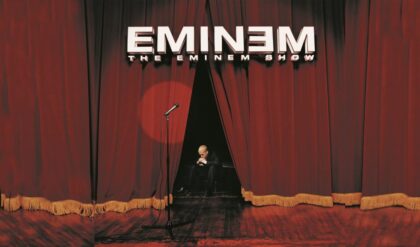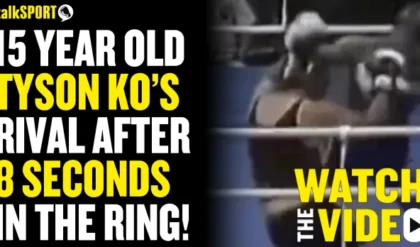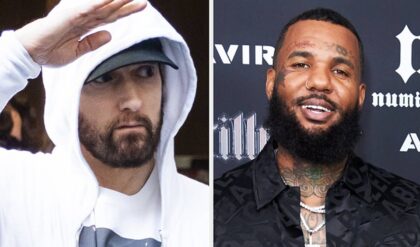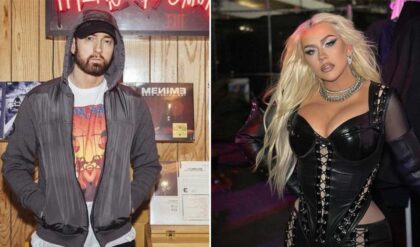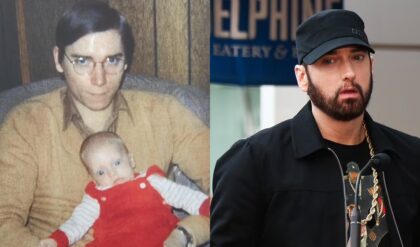Two decades ago this weekend, rap’s most infamous bogeyman kicked off his reign with ‘The Slim Shady LP,’ his last album before money, fame, and the controversy that’s followed him since
He was so young, so raw, so angry, so hungry, so irresistibly crass. But at first, almost everyone managed to resist Marshall Mathers. “You bitches get a hysterectomy disrespectin’ me,” boasted the Detroit rapper known semi-professionally as Eminem on his very independent 1996 debut album, Infinite. “You wanna feel the full effect of me, hand a TEC to me / Intellectually superior, I’ll make the wack wearier / Inferior, deteriorate, like bacteria.”
Sir, this is an Arby’s. The song is called “Open Mic” and sounds like it, gloomy and brash but not a little amateurish. You could marvel at the kid’s abrasive charisma, and maybe even laugh at his dopiest it-came-from-the-third-grade punch lines (“You couldn’t flip shit playin’ in toilets with a spatula”), but still find young Em far too dense, too clever, too Nas-worshiping earnest, too fixated on rhyming for rhyming’s sake. Not wack, exactly, but certainly wearying, his wordplay often so overwrought it devolved into word salad. Like many a petulant early 20-something with precious little to his name and way too much to prove, he was, to put it simply, using way too many napkins.
Infinite sold as few as 70 copies (per Eminem’s autobiography) and as many as a few hundred (per his early producers, the Bass Brothers, who concede that “we couldn’t get arrested back then. It was like, ‘Oh, here comes the white rapper’”). It flopped hard, in any event. “After that record, every rhyme I wrote got angrier and angrier,” Em told Rolling Stone a few years later. “A lot of it was because of the feedback I got. Motherfuckers was like, ‘You’re a white boy, what the fuck are you rapping for? Why don’t you go into rock ’n’ roll?’ All that type of shit started pissing me off.”
/cdn.vox-cdn.com/uploads/chorus_image/image/63081287/SlimShadyLPat20_Getty_Ringer.0.jpg)
And then, he had a revelation. On the toilet. That’s probably just coincidence. This revelation consisted of two words: Slim Shady. “Boom, the name hit me, and right away I thought of all these words to rhyme with it,” Em recalled. “So I wiped my ass, got up off the pot and, ah, went and called everybody I knew.”
The Slim Shady EP, released in December 1997, was a massive, disquieting improvement, deep and dark and concussive, a horrorcore funhouse ride to Actual Hell, from the Black Flag–style mirror-smash cover art to the song called “Just Don’t Give a Fuck” to the other song, then called “Just the Two of Us,” in which Em and a cooing baby girl hit the beach to dispose of the murdered corpse of that baby’s mother. A star, and a scourge, and an intergalactic bogeyman was on the verge of being born.
One night soon thereafter, Em came home to the Detroit apartment he was sharing with friends—his infant daughter, Hailie, and her mother, Kim, were living elsewhere—and found an eviction notice. “I had to break in,” he told Rolling Stone. “I didn’t have anywhere else to go. There was no heat, no water, no electricity. I slept on the floor, woke up, went to L.A. I was so pissed.” He was in L.A. for a national MC battle called the Rap Olympics. He finished second, to his dismay; first prize was $500 and a Rolex. (“He really looked like he was going to cry,” recalled longtime manager and future album-skit superstar Paul Rosenberg.) But during that trip, Dr. Dre and Interscope Records cofounder Jimmy Iovine stumbled across a copy of The Slim Shady EP, and Dre’s response was immediate: “In my entire career in the music industry, I have never found anything from a demo tape or a CD. When Jimmy played this, I said, ‘Find him. Now.’”
They found him.
The Slim Shady LP, executive produced by Dr. Dre and released by Interscope and Dre’s own Aftermath Entertainment, came out 20 years ago this weekend, on February 23, 1999. Buoyed by the MTV-born smash single “My Name Is,” it remains as delightful and whimsical a delivery system for pure ultraviolence as you could imagine, or polite society could stand. “Got pissed off and ripped Pamela Lee’s tits off / And smacked her so hard I knocked her clothes backwards like Kris Kross.” The vast majority of that line didn’t make it on MTV, but the kids, ah, got the message. The record debuted at no. 2 on the Billboard album chart, lower that first week than TLC’s FanMail but higher than The Miseducation of Lauryn Hill; it would be the last time an Eminem record didn’t immediately hit no. 1. Commercially, he was set for life. Quality-wise, he’d get a little better from there, and then, alas, a whole lot worse.
That Rolling Stone interview was for an April 1999 cover story, by the way. The first of many. “In three short months,” the subhead ran, “24-year-old Marshall Bruce Mathers III has gone from white trash to white hot.” Not the most elegant way to put it, but then again, elegance had never gotten him anywhere.
The Slim Shady LP was never designed to age gracefully; the guy who made it, even less so. It is a testament to the impeccable craft of the baby-at-the-beach song—re-recorded to include actual coos from Em’s actual daughter and rechristened “’97 Bonnie & Clyde”—that it can still shock you anew two decades later. The insidious bounce of the Will Smith sample. Baby Hailie’s oblivious babble. The Oscar-worthy folio work as Em drags the corpse across the sand. The tabloid prurience of his by-then notorious enmity for Kim, Hailie’s real-life mother, whom Em would marry and divorce twice. The vicious simplicity of the lyrics. (“And mama said she wants to show how far she can float / And don’t worry about that little boo-boo on her throat.”) Marilyn Manson, late-’90s pop music’s other incorrigible supervillain, would later claim he’d turned down an offer to sing on the track, as he considered it “too over-the-top for me to associate with.” It’s one of the catchiest songs Eminem ever wrote, and for sure the second-ugliest.
That tune is also one of the reasons Billboard greeted the runaway success of The Slim Shady LP with an alarmingly furious editorial, written by then-editor-in-chief Timothy White, accusing Em of “making money by exploiting the world’s misery.” White loosely tied the album to a recent spree of violent crimes committed against teenage girls in Los Angeles, describing at appalled length the song “Guilty Conscience,” a flippant back-and-forth between Dre and Em wherein they debate the pros and cons of armed robbery, assault, the rape of a passed-out 15-year-old girl, and murder, complete with a Dee Barnes shout-out. “Indeed,” White concluded, “to champion the objectification of human beings as mere exploitable sex props leads us back to the worst crime against humanity in history—slavery.”
Eminem responded with the sneering dismissiveness you’d expect from a guy whose debut album includes an EP-holdover song called “Just Don’t Give a Fuck,” which is followed five tracks later by another, new song called “Still Don’t Give a Fuck.” What is still striking, though, about The Slim Shady LP now is how attractive music this gleefully repellent can still be, how even the tune called “Cum on Everybody” has an irresistible house-party bounce, how even a sordid tale with the apparent autobiographical weight of “Brain Damage” has a nursery-rhyme lilt to it. That’s the one where Eminem calls out his grade-school bully, DeAngelo Bailey, by name in the midst of an ultraviolent revenge fantasy; Bailey did an unnervingly jovial interview for that Rolling Stone piece (“Hey, you have his phone number?”) but later sued Em for $1 million for defamation. The judge rapped a little while dismissing the suit.
What’s harder to grasp in 2019 is the vitality and utter necessity of Dr. Dre’s role—not just as a superstar rapper-producer lending his laconic sparkle to the likes of “My Name Is” and “Guilty Conscience” and the grimly hostile “Role Model,” but as a necessary cosign. “I got a couple of questions from people around me,” Dre admitted at the time. “You know, ‘He’s got blue eyes, he’s a white kid.’ But I don’t give a fuck if you’re purple: If you can kick it, I’m working with you.”
Em was used to that dynamic: In his 2008 memoir The Way I Am, he wrote movingly of his long friendship with Detroit rapper Proof, who was shot and killed in 2006 and played a similar role in Eminem’s early days on the local battle-rap circuit: “I’m not going to sugarcoat it—he was my ghetto pass.” Likewise, Marshall Mathers doesn’t become a pop star—or, at least, a fully industry-accepted rap star—without Dre as his sponsor. The early flood of post-Eminem white rappers all paid at least some fealty to that idea of needing to prove their fealty to the larger culture; it wasn’t until 2016, with the early rise of G-Eazy and Post Malone, that The New York Times’ Jon Caramanica would declare we’d entered “the post-accountability era of white rap.”
Eminem, of course, resisted virtually every other type of accountability. “Role Model” is a song about how he sure as hell isn’t one; the closest he gets to explaining himself at all on The Slim Shady LP are the quite striking songs about poverty and desperation, bracing reminders of where both his hunger and his anger came from. He laments his old $5.50-an-hour job (as a cook at a Detroit grill) on “If I Had,” a Slim Shady EP holdover whose chorus features the line “If I had a magic wand / I’d make the world suck my dick without a condom on while I’m on the john.” And “Rock Bottom” has an alarmingly pretty beat (coproduced, like much of the record, by his old pals the Bass Brothers) and a far less defiant chorus that pinpoints the moment when you’re “mad enough to scream but you sad enough to tear.” That’s tear as in cry. Em wrote it shortly after he got fired from that cook job a few days before Christmas.
But this bygone era of Marshall Mathers is itself awfully tough to imagine now: The Slim Shady LP is also the last album he made when he wasn’t rich and famous and vilified by seemingly everyone, from industry critics to his own horrified loved ones. He had not yet been sued by his mother, Debbie Mathers-Briggs, for $10 million over his allegations of her drug use on “My Name Is.” He not yet been sued by his then-wife, also for $10 million, for “the intentional infliction of emotional distress” triggered by “Kim,” one of the most viscerally upsetting rap songs ever born, a screaming murder fantasy and “’97 Bonnie & Clyde” prequel that anchors Em’s 2000 album The Marshall Mathers LP, which nonetheless remains one of the best 21st-century rap albums ever made. (Em and Kim got divorced in 2001, and then remarried—and re-divorced—in 2006.) No high-profile drug addiction and jogging-based recovery. No further commercial mega-successes (see 2010’s comeback Recovery) and critical failures (uh, also Recovery). No latter-day feuds with many of his white-rapper disciples. Slim Shady is his first album as a monster, and his last as a mere human.
What is especially striking about late-period Eminem, with his ferocious but complicated anti-Trump rhetoric and his oft-impenetrable technical density, is that in moments it hearkens all the way back to 1996, to Infinite, to his inferior-deteriorate-bacteria days as a word-salad connoisseur. “Sometimes I’ll realize when a song is done that it’s just words, it’s not saying anything,” Em told David Marchese in an engrossing 2017 interview for New York magazine. “There’s no message, no concept. I’ll record a song and play it in the car and be like, ‘This ain’t about nothing.’ That obviously means it’s not good enough.” It’s not that he watered down his technical ability to make The Slim Shady LP and the best of what came after, but that he sharpened every word to a lethal point. Simply to horrify. He got that balance exactly right for only a little while. The world might be better off that he couldn’t keep it up for long.

